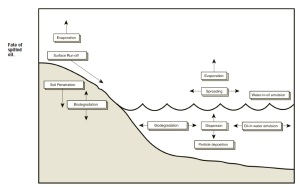NATURAL ACTIONS are always at work in aquatic environments. These can reduce the severity of an oil spill and accelerate the recovery of an affected area. Some natural actions include weathering, evaporation, oxidation, biodegradation, and emulsification.
• Weathering is a series of chemical and physical changes that cause spilled oil to break down and become heavier than water. Wave action may result in natural dispersion, breaking a slick into droplets which are then distributed vertically throughout the water column. These droplets can also form a secondary slick or thin film on the surface of the water.
• Evaporation occurs when the lighter or more volatile substances within the oil mixture become vapors and leave the surface of the water. This process leaves behind the heavier components of the oil, which may undergo further weathering or may sink to the bottom of the ocean floor. Spills of lighter refined products, such as kerosene and gasoline, contain a high proportion of flammable components known as light ends. These may evaporate within a few hours, causing minimal harm to the aquatic environment. Heavier oils, vegetable oils, and animal fats leave a thicker, more viscous residue. These types of oils are less likely to evaporate.
• Oxidation occurs when oil contacts the water and oxygen combines with the oil hydrocarbons to produce water soluble compounds. This process affects oil slicks mostly around their edges. Thick slicks may only partially oxidize, forming tar balls. These dense, sticky black spheres may linger in the environment, washing up on shorelines long after a spill.
• Biodegradation occurs when microorganisms, such as bacteria, feed on oil hydrocarbons. A wide range of microorganisms is required for a significant reduction of the oil. To sustain biodegradation, nutrients such as nitrogen and phosphorus are sometimes added to the water to encourage the microorganisms to grow and reproduce. Biodegradation tends to work best in warm water environments.
• Emulsification is the process that forms emulsions, which are mixtures of small droplets of oil and water. Emulsions are formed by wave action, and they greatly hamper weathering and cleanup processes. Two types of emulsions exist: water-in-oil and oil-in-water. Water-in oil emulsions are frequently called “chocolate mousse,” and they are formed when strong wave action causes water to become trapped inside viscous oil. Chocolate mousse emulsions may linger in the environment for months or even years. Oil and water emulsions cause oil to sink and disappear from the surface, giving the visual illusion that it is gone and the threat to the environment has ended.
Reference

